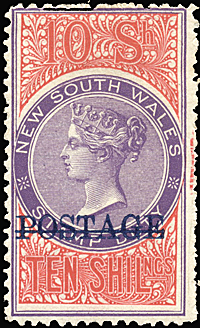The 1885 proposal to use postage stamps to pre-pay telegram charges.
- Australia 1901-1988
- New South Wales
- Overview of NSW
- Telegraph lines
- Telegraph Offices
- Date stamps
- Forms
- Envelopes
- Instructional annotation
- Collect
- Delayed
- Free
- Immediate Urgent
- Reply paid
- Rates
- Stamps
- 1871 Telegraph stamps
- 1885 proposal
- 1893 proposal
- Queensland
- South Australia
- Tasmania
- Victoria
- Western Australia
- International
- Special aspects
After the first unsuccessful attempt to issue Telegraph stamps to prepay telegram charges, two other attempts were made. The second and third periods during which stamps were authorised for use in New South Wales to prepay telegraph charges were:
The possibility of pre-paying telegraph charges with stamps was raised again in on 17 August 1885 by Mr. P. B. Walker, the Assistant Superintendent of Telegraphs. To by-pass the previous difficulty with the 1857 Electric Telegraph Act, the use of postage stamps was approved on 22 September. Hence the regulations, which took effect from 1 October 1885, now stated:
"1. The charges on telegrams are to be prepaid by stamps, and the public will be required to affix them to the message form, just as they are required to affix them to letters.
2. Stamps are to be sold by the officers who may receive the telegrams and are to be cancelled with the obliterating stamp. Combined offices will use their post office date stamp for this purpose."
Unfortunately no-one had informed the Premier and he apparently had read about the changes in the newspapers. He was immediately concerned with the costs which would be incurred to print the extra stamps required.
A typical newspaper report is that from the Goulburn Evening Penny Post of 24 September 1885:
Prepayment of Telegrams by Stamps.
"Instructions have been received by telegraph station masters throughout the colony that on and after 1st October next all telegrams must be prepaid by postage stamps affixed to message forms, and that collect messages (press excepted) will not be accepted unless in answer to those containing the words "reply paid." A telegraph message must therefore, after the date mentioned, be stamped in the same way as a letter. The regulation is an excellent one and will tend to greatly expedite business in the telegraph department by leaving the lines open for the transaction of nothing but public business. At the present the accounts are kept by wire and this necessarily occupies a considerable amount of time".
The basic rates for sending a telegram between 1884 and 1893 were:
- for sending a telegram less than 15 miles within New South Wales: 6d;
- for sending a telegram between two adjacent Colonies: 1/-.
These basic rates remained in force until 1923.
Postage stamps on issue in 1885 and through to about 1910, which could also be used to pre-pay telegram charges, were printed on paper with watermark Crown over NSW with various perf combinations including 10, 13, 10×13,etc. The stamps were:
 1d salmon. Perf 11 ×12. Overprinted OS for Official purposes. Used especially for "extra word" rate. |
 2d Prussian blue. (1862 - 1897). Printed with various watermarks and perforations. |
 3d green Small Diadem. 1891 printed on single-lined single watermark paper. |
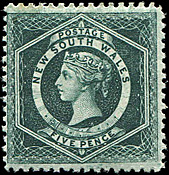 5d Diadem. 1903-08: 3rd Crown NSW watermark. |
 6d mauve. (Jan. 1872 to Nov. 1888). Printed on Crown over NSW watermarked paper. |
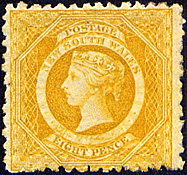 8d yellow Diadem. (Dec 1855 - Jan 1889). Perf 10 with variations. |
 9d 1903-05 Commonwealth design. See also the corresponding Queensland issue. |
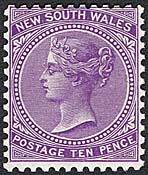 10d violet. |
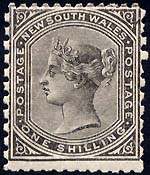 1/- black. (April 1876 to February 1889). Printed on Crown over NSW watermarked paper. |
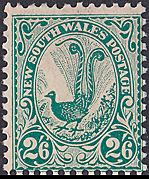 2/6 green lyre bird. 1902-03. Crown NSW (1 mm spacing) watermark. Perf 12 × 11½. |
 5/- purple. (1861 - 1888). Perf 12 or 10 × 12. |
The 5/- "Coin" (see above) was the highest denomination for NSW postage stamps in 1885. This stamp was very slow to print using the recess method and the normal process produced between 1,000 and 1,500 per month. The Government Printer was therefore asked to design both a 10/- and a £1 higher denomination postage stamp. He suggested the use of the plates for the Stamp Duty stamps which had 21 denominations ranging from 1d to 20/-. In addition, they would be quick to print.
| The 5/- Duty Stamp was also overprinted POSTAGE to meet the demand.
About 16,400 of these 5/- stamps were issued to the Telegraph Department in the six months from October 1885. In contrast, none of the 10,000 stamps overprinted of each of the 10/- and £1 denominations came to the Telegraph Branch. Indeed, although the stamps had been overprinted and prepared, they were not issued until after this phase of using postage stamps to prepay costs for telegrams had been abandoned - in April 1886. The following PMG announcement summarises the situation: "The system of pre-payment of telegrams by postage stamps was introduced on 1st October but being found to be open to the serious objection that it possessed absolutely no check upon the collections of country Station-Masters, besides being otherwise objectionable, it was abolished and the cash system reverted to on the 1st April 1886".
|
 5/- green and lilac Stamp Duty overprinted POSTAGE. Perf 12 × 10. Millennium Auctions Sale 54 November 2012, Lot 737. |
| Hence, despite the need for higher denominations in the Telegraph Department, only the 5/- overprinted POSTAGE stamp was used for pre-payment of telegrams during this 1885-86 experiment.
About 8,000 stamps were delivered into stock in October 1885 with another 8,500 delivered in January 1886. They were printed on blue paper with a NSW watermark Type I (21 mm long) and perforated 11½ x 10. The central vignette was printed in lilac. The 5/- stamps were surface-printed from electroplates made by De La Rue in 1866. Each plate contained two panes of 50 stamps. Bassett Hull (1911) notes that a 5/- was known telegraphically. Wish we knew where it was now. |
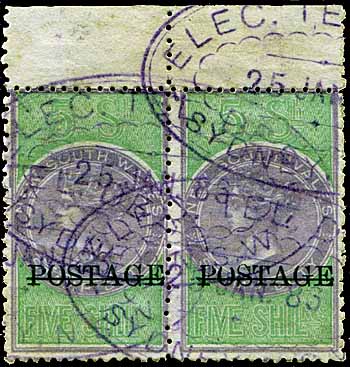 Marginal pair of the 5/- Stamp Duty overprinted POSTAGE. Used at the Electric Telegraph Department on 25 January 1886. Provenance: Dave Elsmore. Only example of a Electric Tele. date stamp used on these stamps. |
The 10/- Stamp Duty overprinted POSTAGE was also reported without evidence as having been used for telegrams. Allegedly it had to await the third period - it was not used during the 1885-86 period.
It can be inferred that the use of postage stamps to pay telegram charges was not supported by all. The New England Advertiser for 13 March 1886 carries the following comment:
PAYMENT of telegrams by postage stamps does not appear to be a success, or to give satisfaction to the Department, for after a very brief trial the old cash system is to be reverted to from 1st proximo. It was a matter of considerable inconvenience for the sender of a telegram to purchase the exact number of stamps required for its transmission, append them thereto, and then hand the missive to the operator, who was also put to much inconvenience and delay through having to supply the stamps. It has been asserted that the reason for introducing the postage stamp plan was to prevent possibility of fraud on the part of the officials, but it appears that a few months trial has proved to the heads of the Department that there was no warrant for suspecting unscrupulousness by the telegraphic officials.
A new design for the transmission form (NC-TO-7C) was released in 1893 with a small space in the top right corner with "AFFIX POSTAGE STAMPS HERE". It was soon complemented by another design (NC-TO-8) with a printed stamp image.

